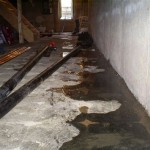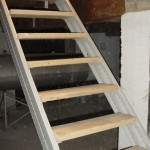How To Finish a Cement Basement Floor
Finishing a cement basement floor transforms a cold, damp space into a comfortable, usable area. This comprehensive guide provides a step-by-step process for achieving a professional-looking finish.
Preparing the Concrete Surface
Proper surface preparation is crucial for a successful finish. This involves cleaning, repairing, and ensuring a level surface for optimal adhesion and a visually appealing outcome.
- Clean the Floor: Thoroughly clean the concrete surface using a stiff-bristled broom and a powerful vacuum to remove all dust, dirt, debris, and loose particles. For stubborn stains or grease, utilize a degreaser specifically designed for concrete.
- Repair Cracks and Imperfections: Fill any cracks, holes, or imperfections with a concrete patching compound. Follow the manufacturer's instructions for application and drying time. Allow the patch to dry completely before proceeding.
- Address Moisture Issues: Check for signs of moisture, such as efflorescence or damp spots. Address any underlying moisture problems before applying a finish to prevent future issues with adhesion and mold growth. A moisture barrier can be applied to the concrete if necessary.
- Level the Floor (If Necessary): If the floor is uneven, use a self-leveling concrete compound to create a smooth surface. Apply the compound according to the manufacturer's instructions and allow sufficient drying time.
Choosing the Right Flooring
Selecting the appropriate flooring is essential, considering factors such as moisture levels, intended use, and budget. Various options offer different advantages and disadvantages.
- Epoxy Coatings: Durable and resistant to moisture, chemicals, and stains, epoxy coatings are a popular choice for basement floors. They are available in a variety of colors and finishes.
- Concrete Paint: A budget-friendly option, concrete paint can enhance the appearance of the basement floor. However, it may not be as durable as epoxy coatings.
- Interlocking Tiles: Easy to install and available in various materials, interlocking tiles provide a quick and versatile flooring solution.
- Carpet Tiles: Offering warmth and comfort, carpet tiles can be installed directly over concrete, provided the moisture levels are controlled. They are also easily replaceable if damaged.
- Floating Floors: These floors "float" over the existing concrete, providing a relatively easy installation process. They are available in various materials, including laminate and engineered wood.
Applying the Chosen Finish
The application process varies depending on the chosen flooring. Carefully following the manufacturer's instructions is crucial for achieving optimal results.
- Primer Application (If Necessary): Some flooring types, such as epoxy coatings and paint, may require a primer to ensure proper adhesion to the concrete. Follow the manufacturer's recommendations regarding primer application.
- Mixing and Applying the Finish: Follow the manufacturer's instructions precisely for mixing and applying the chosen finish. Utilize appropriate tools, such as rollers, brushes, or trowels, depending on the product.
- Drying and Curing Time: Allow adequate drying and curing time before using the finished floor. The drying time varies depending on the product, temperature, and humidity. Consult the manufacturer's instructions for specific drying times.
- Applying Multiple Coats (If Necessary): Some finishes, such as epoxy coatings and paint, may require multiple coats for optimal coverage and durability. Follow the manufacturer's recommendations regarding the number of coats and drying times between applications.
Post-Installation Considerations
Once the floor finish is applied, several considerations ensure its longevity and performance.
- Protecting the Finish: Consider using area rugs or mats in high-traffic areas to protect the finish from wear and tear. Furniture pads can prevent scratches and dents.
- Regular Cleaning and Maintenance: Implement a regular cleaning routine to maintain the appearance and longevity of the floor finish. Use appropriate cleaning products and avoid harsh chemicals that could damage the finish.
- Addressing Spills Promptly: Clean up spills immediately to prevent staining or damage to the floor finish. Avoid using abrasive cleaners or scrub brushes.
Ventilation and Safety
Proper ventilation and safety measures are essential throughout the process.
- Adequate Ventilation: Ensure adequate ventilation during the preparation and application stages, especially when working with epoxy coatings or paints. Open windows and doors or use fans to circulate fresh air.
- Personal Protective Equipment (PPE): Wear appropriate personal protective equipment, such as gloves, eye protection, and a respirator, when working with chemicals or dust.
- Disposal of Materials: Dispose of all materials properly according to local regulations.
Choosing the Right Tools and Materials
Having the right tools and materials ensures a smooth and efficient finishing process.
- Concrete Cleaner and Degreaser: Choose a cleaner specifically designed for concrete to effectively remove dirt, grease, and stains.
- Concrete Patching Compound: Select a high-quality patching compound that is compatible with the chosen finish.
- Primer (If Necessary): Use a primer recommended by the manufacturer of the chosen finish.
- Flooring Material: Carefully select the flooring material based on desired aesthetics, durability, and budget.
- Application Tools: Gather the necessary application tools, such as rollers, brushes, trowels, or sprayers, depending on the chosen finish.
- Safety Equipment: Ensure adequate personal protective equipment, including gloves, eye protection, and a respirator.
By following these steps and considerations, transforming a cement basement floor into a functional and aesthetically pleasing space is achievable. Remember always to consult the manufacturer's instructions for specific product recommendations and application guidelines.

Diy Basement Floor Stain And Finish 2 Colors Without Etching Youtube

How To Stain Concrete Basement Floor Diy Guide

A Guide To Stained Concrete Basement Floors

Polished Concrete Flooring Options For Your Basement Duraamen

Ask Steve Maxwell How To Fix Concrete Floor Cracks With Paint

Alternative Finishes For Interior Concrete Floors Decor

15 Diy Basement Flooring Ideas Affordable Options For Basements

Marblelife Basement

Stained Concrete Basement Floor Ideas

The Ultimate Guide To Staining A Basement Floor Semigloss Design
Related Posts







